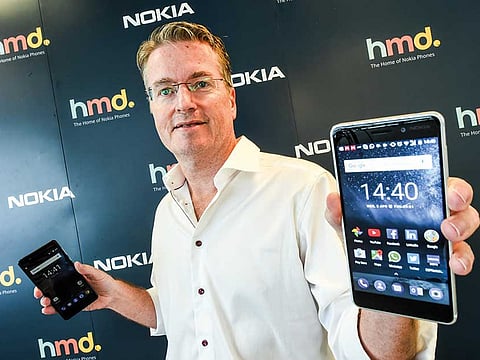Nokia phones are here to stay for long run, HMD says
Unique proposition and strategic partnerships with Foxconn, Nokia and Google cited as key differentiators

Dubai: Nokia phones are here for the long run and sees a bright future for its devices after making a comeback, the regional head of HMD Global told Gulf News in an interview.
“We believe the partners who are with us are in it for a long run. That is the commitment we have,” said Per Ekman, Vice-President for Middle East and North Africa at HMD Global, the company that owns the rights to sell Nokia-branded phones and tablets for 10 years. It develops, builds and sells the phones with inputs from Nokia.
Ekman said the unique proposition and the strategic partnerships with trade partners such as Foxconn, Nokia and Google are going to be the key differentiators.
“Most of the smartphones in the market do not have the Android OS in the way it should be. Vendors are adding a skin on top of the OS. Consumers have the right to have the latest version of the OS and we will be pushing the latest version and the patches as soon as it is available from Google,” he said.
He added that users will find the true Nokia brand attitudes such as reliability, simplicity, ease of use, human touch and quality in the devices.
“We and Google will jointly enhance the Nokia brand to put the right kind of inputs into the phone, including Google Assistant,” Ekman said.
At its peak in 2008, Nokia was the world’s top mobile phone company. It shipped 468 million handsets, of which 60 million were smartphones. It had a mobile market share of whopping 41 per cent then, compared to the current leader Samsung which just had a 19 per cent share in 2016.
Nokia lost its leadership position in 2011 to Samsung and in 2014, sold its business to Microsoft for $7.2 billion (Dh26.44 billion).
But HMD is still making the feature [basic] phones which are still used in many countries, especially in Africa.
According to research firm International Data Corporation (IDC), 215.33 million mobile handsets were shipped in Africa during 2016. Out of this, feature phones totalled 119.97 million units with a 16.1 per cent year-on-year increase compared to 3.4 per cent year-on-year increase in smartphone shipments to 95.37 million units.
This growth saw feature phones increase their unit share of Africa’s overall handset market from 53 per cent in 2015 to 56 per cent in 2016.
“Feature phones are still a sizeable business globally. In the region, Nokia has a market share of between six and seven per cent,” Ekman said.
He added that Nokia tested the launch this year in January in the toughest market — China, with Nokia 6, to see if customers are happy with the brand and the device.
HMD sold more than one million handsets in pre-registration within 23 seconds of the announcement in China.
“It is a fantastic opportunity that we have now. Android is the consumer choice for the smartphone platform. Symbian and Microsoft were more of a niche platform, and did not deal with the consumer appeal in terms of apps,” he said.
The first wave of products to hit the market in this quarter is Nokia 3, Nokia 5, Nokia 6 and Nokia 3310.
He did not give the exact date or month of launch but industry experts say the launch would happen by the end of May or early June in 120 markets.
Sign up for the Daily Briefing
Get the latest news and updates straight to your inbox



